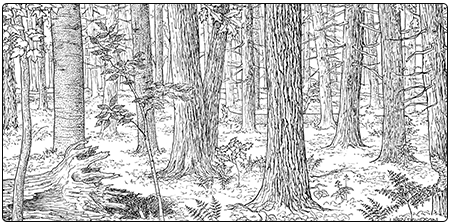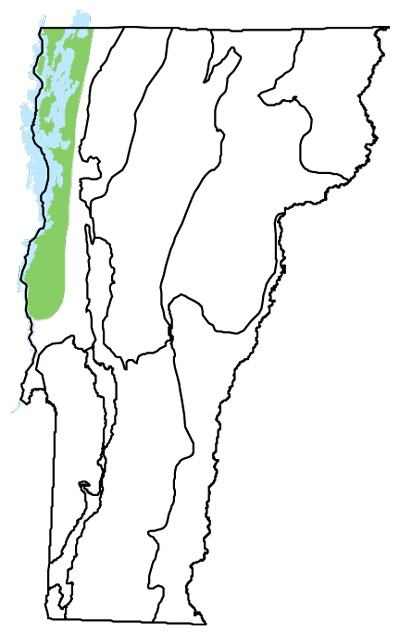Ecology and Physical Setting
While most of the lower elevations in the Champlain Valley have deep clay deposits, near-lake areas have overlying sand layers that reflect the dynamic post-glacial movement and deposition of sediments. Sand-Over-Clay Forests occur in the Champlain Valley, where they form large patches along and near the mouths of several rivers, including Otter and Little Otter Creeks. They are commonly interspersed with the slightly lower and wetter Wet Sand-Over-Clay Forests. Like other clayplain forests, Sand-Over-Clay Forests have a diverse canopy of tall trees, stone-free soils, and flat topography.
The presence of an acidic sand layer over nutrient-rich clay has a strong effect on the floristic composition of the forest. The depth of the sand (from several inches to over four feet) affects both the soil drainage and the ability of plant roots to reach the fertile clays. In general, the tree diversity is high and tree species indicative of enrichment are common, likely because the tree roots reach to the underlying clay layer. In contrast, there are few enrichment indicators in the herb layer, likely due to the shallower roots not reaching to the underlying clay. When herbs indicative of mineral enrichment are present, they are typically associated with wetter depressions and with areas of seepage on shallow slopes. Tree tip-ups play a role in creating microtopography, with hummocks of deeper sand supporting regeneration of upland species, and wet hollows supporting wetland species.
These forests occur most commonly on Swanton, Melrose, Enosburg, Munson, and Whately soil series—all with sand, silt, or loam overlying clay. Sand-Over-Clay Forest always has a sand layer of sufficient depth to allow an upland forest community to develop, even though some of these soils are classified as poorly or very poorly drained.
Sand-Over-Clay Forest is one of the natural communities of the Champlain Valley clayplain forest ecosystem, which is described under the Mesic Clayplain Forest natural community.
Vegetation
Sand-Over-Clay Forests are characterized by high tree diversity—more than 25 species of trees have been identified in some of the known examples—but hemlock or red maple tend to dominate the closed canopies. Other trees that are commonly present in varying abundance include red oak, white pine, sugar maple, white oak, shagbark hickory, white ash, beech, and yellow birch. This is one of the few natural communities where yellow birch (a generally northern and cool climate species) consistently occurs with oaks and hickories. Other trees include bitternut hickory, basswood, bigtooth aspen, black birch, swamp white oak, and musclewood.
In forests strongly dominated by hemlock, the shrub and herb layers can be very sparse. Under deciduous tree canopies, shrubs and herbs are much more abundant. The most common shrubs are witch hazel, prickly ash, maple-leaved viburnum, winterberry holly, arrowwood, and black huckleberry. The herb layer is ferny, with a mix of upland and wetland species, including intermediate wood fern, New York fern, lady fern, marginal wood fern, cinnamon fern, interrupted fern, and bracken fern. Sandy hummocks and areas with thicker sand layers have herbs indicative of dry, nutrient-poor conditions, including Canada mayflower, goldthread, Indian cucumber root, wintergreen, and partridgeberry. Cinnamon fern and sensitive fern occur in moist depressions. The uncommon loose-flowered sedge is characteristic of Sand-Over-Clay Forest. Many other herbs are present in low abundance. Occasional species indicative of enrichment include bloodroot, red baneberry, and lopseed. Bryophytes are very sparse on the sandy and leafy forest floor but may be abundant on fallen logs.
Wildlife Habitat
Sand-Over-Clay Forest varies from hardwood-dominated to hemlock-dominated, and this variation affects wildlife habitat. Examples with beech and oaks provide hard mast for many species, including gray squirrel, chipmunk, and gray fox. These hardwood sites support breeding eastern wood pewees, blue-headed vireos, wood thrushes, and hairy woodpeckers. Hemlock-dominated forests are more likely to support breeding Blackburnian warblers and red-breasted nuthatches. Trees grow very large in these fertile forests, and the peeling bark of shagbark hickory provides summer roosts for Indiana bats and other bats. Most Sand-Over-Clay Forests occur near the sluggish lower reaches of Champlain Valley rivers, where beavers are common, and beaver-chewed trees are frequent.
Successional Trends
The abundance of red maple in some Sand-Over-Clay Forests may be related to past land use history. Over time, we expect red maple to largely be replaced by hemlock, oaks, shagbark hickory, white pine, ashes, and sugar maple. In general, seedlings and saplings of these species are more abundant than those of red maple. Tree tip-ups play an important role in creating microtopography. Dry hummocks and moist hollows increase diversity by supporting a mix of upland and wetland species.
Related Communities
- Mesic Clayplain Forest occurs primarily on Vergennes clay and has a similarly diverse forest of oaks and hickories, but with more herbs indicative of enrichment from fertile clays.
- Wet Sand-Over-Clay Forest is a wetland community with a higher water table in the sand soils. Green ash and red maple are often dominant, but upland species can also be present.
- Dry Pine-Oak-Heath Sandplain Forest occurs on deep, dry sandy soils and is dominated by white and pitch pine with red and black oaks. There may be clay deep beneath the sand, but it has no effect on the vegetation or hydrology.
Conservation Status and Management Considerations
This natural community occurs on a rare landform—sand-over-clay soils derived from glacial lakes and seas. Like other communities of the Champlain
Valley clayplain forest ecosystem, most of the Sand-Over-Clay Forest has been converted to agricultural use. Many of the remaining examples are on conserved lands. These forests should be managed for high ecological integrity that allows natural processes to occur and maintains plant and animal diversity.
Distribution/Abundance
Sand-Over-Clay Forests are found in the lower elevations of the Champlain Valley where sand deposits overlie the lacustrine and marine clays. They are primarily found along and near the mouths of rivers. Related forests with sand-over-clay soils are found on the glacial lakeplain around the lower Great Lakes.
Characteristic Plants
Trees
Abundant Species
Eastern hemlock – Tsuga canadensis
Red maple – Acer rubrum
Red oak – Quercus rubra
White pine – Pinus strobus
Sugar maple – Acer saccharum
White oak – Quercus alba
Shagbark hickory – Carya ovata
White ash – Fraxinus americana
American beech – Fagus grandifolia
Yellow birch – Betula alleghaniensis
Occasional to Locally Abundant Species
Bitternut hickory – Carya cordiformis
Basswood – Tilia americana
Bigtooth aspen – Populus grandidentata
Black birch – Betula lenta
Swamp white oak – Quercus bicolor
Musclewood – Carpinus caroliniana
Hophornbeam – Ostrya virginiana
Bur oak – Quercus macrocarpa
Black cherry – Prunus serotina
Green ash – Fraxinus pennsylvanica
Quaking aspen – Populus tremuloides
Shrubs
Witch hazel – Hamamelis virginiana
Prickly ash – Zanthoxylum americanum
Maple-leaved viburnum – Viburnum acerifolium
Winterberry holly – Ilex verticillata
Arrowwood – Viburnum dentatum
Black huckleberry – Gaylussacia baccata
Poison ivy – Toxicodendron radicans
Virginia creeper – Parthenocissus quinquefolia
Herbs
Intermediate wood fern – Dryopteris intermedia
New York fern – Parathelypteris noveboracensis
Lady fern – Athyrium filix-femina
Marginal wood fern – Dryopteris marginalis
Interrupted fern – Osmunda claytoniana
Bracken fern – Pteridium aquilinum
Cinnamon fern – Osmundastrum cinnamomeum
Sensitive fern – Onoclea sensibilis
Canada mayflower – Maianthemum canadense
Goldthread – Coptis trifolia
Indian cucumber root – Medeola virginiana
Wintergreen – Gaultheria procumbens
Partridgeberry – Mitchella repens
Bearded shorthusk – Brachyelytrum aristosum
Bloodroot – Sanguinaria canadensis
Red baneberry – Actaea rubra
Lopseed – Phryma leptostachya
Rare and Uncommon Plants

ecosystem. The nuts are prized by squirrels and chipmunks.
Loose-flowered sedge – Carex laxiflora
American hazelnut – Corylus americana
Black gum – Nyssa sylvatica
Yellow bartonia – Bartonia virginica
Associated Animals
Eastern gray squirrel – Sciurus carolinensis
Southern flying squirrel – Glaucomys volans
Gray fox – Urocyon cinereoargenteus
Eastern chipmunk – Tamias striatus
American beaver – Castor canadensis
Eastern wood pewee – Contopus virens
Blue-headed vireo – Vireo solitarius
Yellow-throated vireo – Vireo flavifrons
Scarlet tanager – Piranga olivacea
Hermit thrush – Catharus guttatus
Wood thrush – Hylocichla mustelina
Hairy woodpecker – Picoides villosus
Red-breasted nuthatch – Sitta canadensis
Blackburnian warbler – Setophaga fusca
Rare and Uncommon Animals
Indiana bat – Myotis sodalis
Red-bellied woodpecker – Melanerpes carolinus
Tri-colored bat – Perimyotis subflavus
Eastern small-footed bat – Myotis leibii
Places to Visit
Round Pond State Park, South Hero, Vermont Department of Forests, Parks, and Recreation
LaPlatte River Marsh Natural Area, Shelburne, The Nature Conservancy
Lower Otter Creek Wildlife Management Area, Ferrisburg, Vermont Fish and Wildlife Department (VFWD)
Little Otter Creek Wildlife Management Area, Ferrisburg, VFWD
Whitney/Hospital Creek Wildlife Management Area, Addison, VFWD
